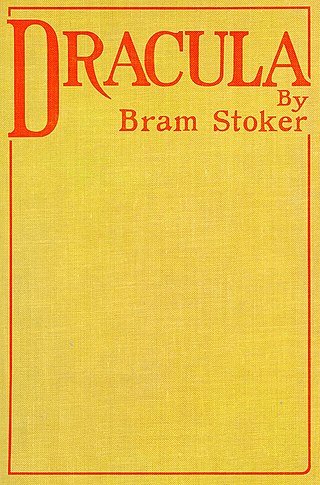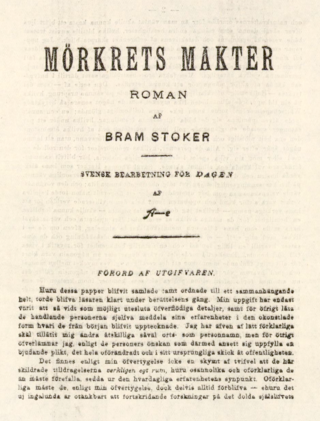
Abraham "Bram" Stoker was an Irish author who wrote the 1897 Gothic horror novel Dracula. During his life, he was better known as the personal assistant of actor Sir Henry Irving and business manager of the West End's Lyceum Theatre, which Irving owned.

Dracula is a 1897 Gothic horror novel by Irish author Bram Stoker. An epistolary novel, the narrative is related through letters, diary entries, and newspaper articles. It has no single protagonist and opens with solicitor Jonathan Harker taking a business trip to stay at the castle of a Transylvanian nobleman, Count Dracula. Harker escapes the castle after discovering that Dracula is a vampire, and the Count moves to England and plagues the seaside town of Whitby. A small group, led by Abraham Van Helsing, investigate and hunt the vampire.

Gothic fiction, sometimes called Gothic horror, is a loose literary aesthetic of fear and haunting. The name refers to Gothic architecture of the European Middle Ages, which was characteristic of the settings of early Gothic novels.

The undead are beings in mythology, legend, or fiction that are deceased but behave as if they were alive. A common example of an undead being is a corpse reanimated by supernatural forces, by the application of either the deceased's own life force or that of a supernatural being. The undead may be incorporeal (ghosts) or corporeal.

Vampire literature covers the spectrum of literary work concerned principally with the subject of vampires. The literary vampire first appeared in 18th-century poetry, before becoming one of the stock figures of gothic fiction with the publication of Polidori's The Vampyre (1819), inspired by a story told to him by Lord Byron. Later influential works include the penny dreadful Varney the Vampire (1847); Sheridan Le Fanu's tale of a lesbian vampire, Carmilla (1872), and the most well known: Bram Stoker's Dracula (1897). Some authors created a more "sympathetic vampire", with Varney being the first, and more recent examples such as Moto Hagio's series The Poe Clan (1972–1976) and Anne Rice's novel Interview with the Vampire (1976) proving influential.

The Jewel of Seven Stars is a horror novel by Irish writer Bram Stoker, first published by Heinemann in 1903. The story is a first-person narrative of a young man pulled into an archaeologist's plot to revive Queen Tera, an ancient Egyptian mummy. It explores common fin de siècle themes such as imperialism, the rise of the New Woman and feminism, and societal progress.

Erotic horror, alternately called horror erotica or dark erotica, is a genre of fiction in which sensual or sexual imagery are blended with horrific overtones or story elements for the purpose of sexual arousal. Horror fiction of this type is most common in literature, film and video games.

Count Dracula is the title character of Bram Stoker's 1897 gothic horror novel Dracula. He is considered the prototypical and archetypal vampire in subsequent works of fiction. Aspects of the character are believed by some to have been inspired by the 15th-century Wallachian prince Vlad the Impaler, who was also known as Vlad Dracula, and by Sir Henry Irving and Jacques Damala, actors with aristocratic backgrounds that Stoker had met during his life.
William Hughes FRHistS FSA Scot is Professor of Literature in English at the University of Macau, China: he has specialised in the study of Bram Stoker. He was educated at the Liverpool Collegiate School and the University of East Anglia, and also holds a PGCE from Christ Church, Canterbury. He has presented radio programmes for the BBC World Service and BBC Radio 4, and has also appeared on live television through Living TV's Most Haunted Live!, most recently during the 2009 broadcast from St George's Hall, Liverpool. In 2015, he was elected a Fellow of the Royal Historical Society and, in 2019, a Fellow of the Society of Antiquaries of Scotland. Prior to accepting a chair at the University of Macau he was, for 26 years, a member of the English faculty at Bath Spa University, England, where he led teaching and research in the fields of Gothic Literature and the medical humanities.
Nina Auerbach was the John Welsh Centennial Professor of English Emerita at the University of Pennsylvania. Her special area of concentration was nineteenth-century England. She published, lectured, and reviewed widely in the fields of Victorian literature, theater, cultural history, and horror fiction and film.
Elizabeth Russell Miller was a Professor Emerita at Memorial University of Newfoundland. She resided in Toronto. In her early academic career, she focused on Newfoundland literature, primarily the life and work of her father, well-known Newfoundland author and humorist Ted Russell. Beginning in 1990, her major field of research was Bram Stoker's novel Dracula, its author, sources and influence. She published several books on the subject, including Reflections on Dracula, Dracula: Sense & Nonsense, a volume on Dracula for the Dictionary of Literary Biography and, most recently, Bram Stoker's Notes for Dracula: A Facsimile Edition with Robert Eighteen-Bisang. She founded the Dracula Research Centre and was the founding editor of the Journal of Dracula Studies now at Kutztown University of Pennsylvania.

Urban Gothic is a sub-genre of Gothic fiction, film horror, and television dealing with industrial and post-industrial urban society. It was pioneered in the mid-19th century in Britain, Ireland, and the United States, before being developed in British novels such as Robert Louis Stevenson's Strange Case of Dr Jekyll and Mr Hyde (1886) and Irish novels such as Oscar Wilde's The Picture of Dorian Gray (1890) and Bram Stoker's Dracula (1897). In the twentieth century, urban Gothic influenced the creation of the sub-genres of Southern Gothic and suburban Gothic. From the 1980s, interest in the urban Gothic was revived with books like Anne Rice's Vampire Chronicles and a number of graphic novels that drew on dark city landscapes, leading to adaptations in film including Batman (1989), The Crow (1994) and From Hell (2001), as well as influencing films like Seven (1995).

The Mystery of the Sea is a mystery novel by Bram Stoker, first published in 1902. It tells the story of an Englishman living in Aberdeenshire, Scotland, who meets and falls in love with an American heiress. She is involved with the intrigues of the Spanish–American War, and a complex plot involving second sight, kidnapping, and secret codes unfolds over the course of the novel.
John Edgar Browning is an American author, editor, and scholar known for his nonfiction works about the horror genre, Dracula, and vampires in film, literature, and culture. Previously a visiting lecturer at the Georgia Institute of Technology, he is now a professor of liberal arts at the Savannah College of Art and Design in Atlanta, Georgia.
The Lord Ruthven Award is an annual award presented by the Lord Ruthven Assembly, a group of academic scholars specialising in vampire literature and affiliated with the International Association for the Fantastic in the Arts (IAFA).
Robert Eighteen-Bisang was a Canadian author and scholar who was one of the world's foremost authorities on vampire literature and mythology.

Dr Samantha George is a Senior Lecturer in Literature in the Social Sciences, Arts & Humanities Research Institute at the University of Hertfordshire. She completed a PhD at the University of York in 2004, then taught in the Department of English Literature at Sheffield University till taking up her post at Hertfordshire in 2007. She is known for her research on eighteenth century literature and science with a particular emphasis on the role of women and botany.
Bibliography of works on Dracula is a listing of non-fiction literary works about the book Dracula or derivative works about its titular vampire Count Dracula.

Powers of Darkness is an anonymous 1899 Swedish version of Bram Stoker's 1897 novel Dracula, serialised in the newspaper Dagen and credited only to Bram Stoker and the still-unidentified "A—e."

Charlotte Matilda Blake Thornley Stoker (1818–1901) was an Irish writer, activist and the mother of Bram Stoker. Stoker used some of the stories she told him in his literature.












